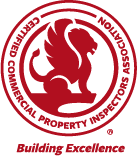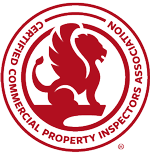An office building inspection involves the inspection of an entire office building. It may cover anything within the property lines, plus multiple floors and tenant spaces. An office suite inspection focuses on a specific individual office suite within a larger building. These spaces may be leased or purchased. An office suite could be a medical office suite or general office suite. A suite may also be referred to as a unit or condo and could apply to industrial, retail, or residential spaces. Many of the considerations for an office suite described here also apply to these uses and occupancies. We will review considerations for the scope of the inspection and answer questions about whether elements extending beyond the suite, like the roof, exterior walls, parking, etc., should be included.
Considerations for an Office Suite Inspection
First, it is important to note that, like any other inspection, an office suite inspection encompasses the items in the ComSOP that exist within the four walls of the contracted property. Beyond that, an office suite inspection encompasses anything that may impact the suite. The inspector should have a clear understanding of their client’s needs, as well as the dynamics of commercial real estate.
An important consideration is the special stipulations for triple-net leases. This type of commercial real estate transaction can include client responsibilities for the maintenance, repair, and replacement of certain building systems and components, as well as common area maintenance (CAM) fees. The latter is a fee tenants pay to landlords for the maintenance of common areas, like parking lots, lobbies, hallways, restrooms, etc.
Here are some common elements:
1. Exterior elements. The exterior elements that impact the unit include parking areas, landscaping, sidewalks, accessibility, lighting, and life safety elements, such as fire access roads and building identification for emergency personnel. Many of these items may fall under the responsibility of a landlord or property manager, but they also impact visitor experience and safety, as well as the overall curb appeal and maintenance fees, if applicable.
People often have questions regarding the inclusion of the exterior walls, roofing, and foundation that extend beyond the suite. These components are typically included for similar reasons. Additionally, the exterior walls, roofing, and foundation offer insight into structural issues that could impact the building in general. It is important to note that moisture intrusion is not confined to individual suites and can easily migrate once it occurs, potentially causing further damage.
2. MEP systems. Inspecting the MEP (mechanical, electrical and plumbing) systems that impact the unit is a straightforward process. The inspector should assess anything designated for the contracted property. So, a rooftop unit or the electrical panel for a separate suite is excluded unless discussed with the client beforehand. Challenges can arise if MEP systems aren’t properly labeled, are located within a different suite, or require other means of special access. There are cases where the main electrical room is located within a different unit, or a sprinkler room is only accessed with the assistance of the property manager. Coordinating access for the inspector is the client’s responsibility.
The scope of an office suite inspection will ultimately depend on the ComSOP and client’s need but, as a general rule of thumb, the inspector should keep in mind that anything that impacts the suite may be included in the inspection. This necessity can be based on the perspective of visitors, the building’s curb appeal, the ongoing building maintenance fees, moisture and water intrusion issues, and the MEP systems. Some inspectors may be inclined to cut corners and assess the specific elements within the building’s four walls, but thoroughly determining the property’s condition requires due diligence, so the inspection will include anything that may impact the suite. The inspector should communicate the scope of work with their clients ahead of time. Many inspectors choose to review this during the preliminary walk-through.
Conclusion
An office suite inspection differs from an office building inspection primarily through mindset and communication. An office building inspection will inherently include anything listed within the ComSOP that are within the property lines of a contracted property. But an office suite inspection should generally include anything that may impact the suite. To apply this concept, the inspector should talk with their clients about a recommended scope of work based on their needs. Those clients buying or leasing an office suite should consider the items beyond the four walls of their contracted property, as well as any special access that may be needed for the inspector to conduct a thorough property inspection.
Additional Resources for Commercial Property Inspectors:


